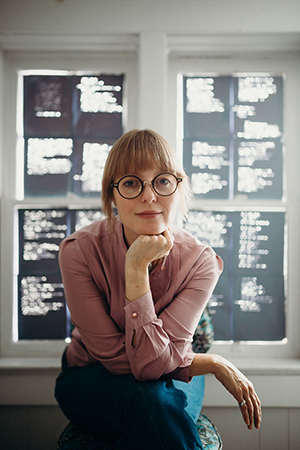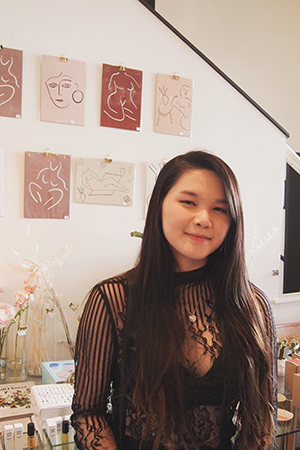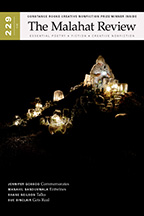Translate the Invisible: Michelle Ha in Conversation with Jennifer Still

Malahat Review past poetry and fiction board intern Michelle Ha talks with Jennifer Still, co-winner of the 2021 Long Poem Prize with her poem, "Legs."
Jennifer Still explores intersections of language and material forms in her home in Treaty 1 territory (now known as Winnipeg, Manitoba, Canada). She is the author of several handmade chapbooks and three poetry books including her latest, Comma (Book*hug 2017), winner of the Lansdowne Prize for Poetry.
Still’s physical poems translate language as light. Her pierced poems have been projected inside The Star Factory Planetarium (University of Manitoba) and installed at The Gallery of Southwestern Manitoba and Aceart Inc. (Illuminations, Mentoring Artists for Women in the Arts, 2018). "Legs" is from her current project, an illuminated long-poem manuscript composed with pinholes, a light table, electric typewriter and carbon sheets.
When you sat down to write "Legs," how did you come about the structure and style of your piece? And what was the evolution like, from the beginning with the idea in your head, to the end with the final draft of your poem?
Funny thing is I never really sat down to write “Legs.” When I think of writing this poem I think about jump squats and swimming and walking back and forth from the beach to the cabin. I think about flipping through my grandma’s Life collection, clipping horsetails, cleaning closets, jotting down a line and then moving around and jotting down another. I think about practicing my pencil float. The lines needed me to be present and aware in my body.
These were the conditions: I had just started this really challenging exercise group. The jump squats killed me! And I was determined to build strength in my legs. Also, I was on a rare solo retreat at our family cabin during a pandemic. I was learning how to find an alone rhythm for five unstructured, unsuppered days. I wanted to get so much done. Everything. Edit a manuscript. Deep clean an entire cabin. Sew 50 chapbooks. And then I realized the only thing I couldn’t do anywhere else for a sustained period of time was listen to myself. To my uninterrupted interiority. And the hummingbird and the space between us. The tension that comes from learning how to keep form and let go, how to be productive without producing—this is where I wrote from.
“Legs” drifted up when my guard was down and my interiority dialled up. The first line came to me vividly. I was buoyed from my morning swim, the honeysuckle beans were in their ripe green form, dashes in the air like pixie legs. I was reading Carolyn Forche’s In the Lateness of the World. In transit between silences, from the shore to the sunroom. I was blissfully content and acutely aware of being inside my body. We can easily forget we are living inside a body, can’t we? Maybe I felt some tenderness toward myself, if that doesn’t sound too weird. Perhaps it was even a mothering feeling. I felt strong and bare. Even free.
I wasn’t writing so much as I was moving and being kind to my own awkward relationship with my body, the body my mother gave me, and thinking about the body she kept and her mother, bodies they/we were never satisfied with, always wanting to improve, as if we were never enough, as if we could be something other than what we were. And the body she tended and decorated and dressed and then left. And my own tending and decorating and dressing of a body that I will carry on and prepare to leave one day.
I spent days like that—wandering and then touching down on the page. Practicing how to push up from the ground and then catch myself softly.
If there’s a structure to this poem, it’s motion. Repetitive motion. My desk was Lake Winnipeg. A rocking desk. I wrote this piece in full-body immersion, kicking around and going nowhere in a great body of water.
I'm very interested in the inspiration behind "Legs," and the themes it explores. What were some influences or inspirations that led you to write this piece? Were there any considerable struggles that you faced while writing it?
All my work in the last six years processes the loss of my mother. “Legs” feels almost like a table of contents of what I’ve written over hundreds of pages. As though each line holds the force of all that grief behind it. All that nonlinear story. I can feel the tension of my entire manuscript in “Legs” and this gives me hope. That I might have come full circle. That I’m orbiting something.
All my work cheers for the mothers. I’m thinking of the maternal body as home. How we circle, pull from, measure ourselves against the mother. Her textures and tones, internal and external, cellular and atmospheric, a layer of self that we are always trying to get at, arrive to, separate from. When she is gone, what is our gravity? How do we negotiate her absence? Is it in fact an absence or has something new moved in?
Possibly I’m talking about a confusion between self and mother too. We want to be our mothers and anything but them. More than them. We are drawn to and repulsed by them. How we think of our mothers may be an indication of how we think of ourselves. Do the stories we tell about our mothers reflect the possibilities we imagine for ourselves? Can we grow beyond our mothers? Do we want to?
My mom was a teenager when she had me. Her becoming is very connected to my own. I remember being young and skinny and thinking how much I wanted to fill out my jeans the way my mom filled out hers. I couldn’t figure out why my bubblegum Silvers just draped and puckered on me while she took up all the space in hers. I wanted her fullness.
I love thinking about and naming the clothing my mom wore—gouchos, knickers, legwarmers, microskirts—and the clothing she dressed me in—seersucker, pedalpushers, leotards, jumpers. Jumpers! Clothing is important somehow. What we choose to cover, what we choose to bare. How we fill out / fill in our forms. My mother was particularly self-conscious about her legs. She was always trying to improve them. And then I think about that moment in the poem when the uncles pinch her legs and call her “chubs.” That memory, that shame, really surprised me because it’s not mine, it’s hers. And so it makes me wonder about how the commentary on women’s bodies resonates for entire lives. Belief systems. Generations. What do we believe about ourselves? Where is this belief rooted in us and how do we wear it? How do we discard it? How do we bare ourselves to ourselves? To each other?
I guess I am trying to locate foundation. What are we built on as women, mothers, daughters, sisters, nieces? What do we stand for?
The judges described your poem as having a "breathless speaker, meditating on her body’s relationship to self, to her mother, and on being a mother—on the ceaseless lineage of mothers," did you find this accurate in how you wanted your themes and message conveyed? Was there more to the message you wanted to say through your poem?
“The ceaseless lineage of mothers” delights me. This is huge and more than I could ever ask a poem to say and yet you’re right, there is more being offered here. I wish I had that much foresight to know what I wanted to say, but I have so little. In poetry, I set out to feel. To learn what I feel. When I read “Legs” today I hear something to do with blossoming and hearts and body acceptance and pronouncing one’s own end. The possibility of ongoingness. How to expand fully into one’s own life, even when it’s cut short. These connections that come out later show me the poem has its own mind, its own structure. It has legs! There’s an interior design reaching out—toeless nude stocking—an expanding form that pushes through the language.
There’s this quote by the paleontologist Teilhard de Chardin: “Matter is spirit moving slowly enough to be seen.” Maybe language—poetry—works this way too. Translates the invisibles. The private tickertape going on in the background of all our lives. The memory, association, hope, fear zipping along inside every lived moment. If a poem can tap into that background and hold it to the light, even for a moment, what will refract?
I like to think about how the past wells up in everything. I fill the hummingbird pendant with sweetwater and think of my mother’s hands. I bake a cherry pie for my daughter’s graduation and there’s so much going on between body and memory as I knead, roll, pit. The pastry drapes into the glass plate like a heavy cloth and I think of my teen mother’s satin wedding dress and my teen daughter’s graduation dress. The heavy cloak of glitter. It’s this collision of memory and imagination and body and real world action happening all at once that I’m listening for. That I hope the poem translates. It’s spectacular, the layers going on within a single person at all times. We are ghosts. We are histories. We are rhythms and futures filled with inevitable loss. And yet we burst forth to our ends. We bake the pie in a heatwave. We lattice the top. We effort. We care. We devour. We love.
When my mom received her terminal cancer diagnosis she raced down to my daughter’s trackmeet and stood beside the starting line. When those young girls’ legs pound by with all their might, my mother is clapping. She’s standing at the end of her life clapping.
Can we see the beginning in our ends and how do we greet our endings? When we stand on the sidelines of our lives are we cheering?
I just don’t want to forget I’m living in a body. And I also want to refuse endings. To believe that somehow this body, this sensual interior imaginative experience, is connected and through these connections, edgeless.
Are you currently working on any new projects that you're excited to share?
I’ll be collaborating with two multimedia artists this year—Chantel Mierau and Christine Fellows—to translate “Legs” into a stop motion video poem! It’s all part of my new manuscript which is multidimensional. It exists on the page and as a single, unspaced line on a daisywheel carbon ribbon. I’ve been working with absences: pinholes, electric typewriter cut-outs, typewriter lift-off tape. All the poems in some way are see-through—they can only be fully experienced when held to the light. I hope they translate grief in some way. And that my printed pages and pop-out pages can all exist together in a single space one day.

Michelle Ha
* * * * * * * *









